Azhakodi Devi Temple or Azhakodi Devi Mahakshethram is a Hindu temple located in Thiruthiyad, Kozhikode District, Kerala, South India. It is one of the famous Devi temples, situated hardly 1.5 km away from the Mofussil Bus stand and 2.5 km from the KSRTC Bus stand, the area still retains the beauty and charm of un-spoilt rural settings within the heart of the Kozhikode city. The temple and the Kalayana Mandapom are administered by the Malabar Devaswom Board.

Thirumandhamkunnu Temple is a historically significant Hindu temple in Angadipuram, which was the capital of Valluvanad Rajavamsham, in Malappuram district, Kerala state, South India. The temple deity, Thirumandhamkunnil amma, was the paradevatha of the kings of Valluvanad, the local feudal kings ruled the area in the Middle Ages. The Nair warriors of Valluvanad king set out from this temple to Thirunavaya, to participate in the famous Mamankam festival. A memorial structure called the chaver thara can be found in front of the main entrance of the Thirumanthamkunnu Temple.
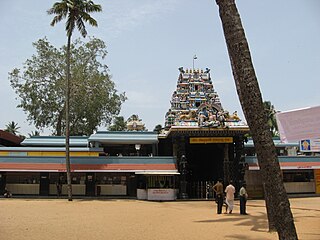
The Attukal Bhagavathy Temple is a Hindu shrine located at Attukal in Kerala, India. It is situated near the heart of the city, two kilometres away from the Padmanabhaswamy Temple, East Fort, in Thiruvananthapuram. The goddess of the temple is identified with Bhadrakali, mounted over a vetala. She is also identified with Kannagi, the heroine of Ilango Adigal's epic Cilappatikaram.
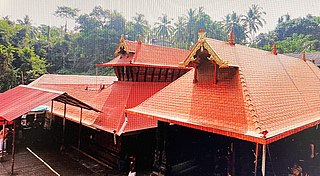
Kadampuzha Devi Temple is a Hindu temple and pilgrimage center at Kadampuzha in Malappuram district, Kerala, India. The main deity of this temple is Goddess Parvati/Durga in the form of a huntress. There is no idol of Goddess in this temple, and she is worshipped in a pit. The presence of Lord Ganesha is also believed to be with the Goddess, and there are sub-shrines for Lord Sastha and serpent deities. A separate Shiva temple exists near the temple, called 'Madambiyarkavu'. Both these temples are under the control of Malabar Devaswom Board.
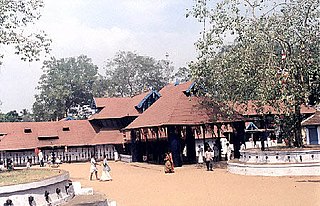
Sree Kurumba Bhagavati Temple is a Hindu temple at Kodungallur, Thrissur District, Kerala state, India. It is dedicated to the goddess Bhadrakali, a form of Mahakali or simply Durga or Aadi Parashakthi worshipped and significantly revered in Kerala. The goddess is known also by the names "Sri Kurumba"". This temple is the head of 64 Bhadrakali temples in Kerala. This Mahakali temple is one of the oldest functioning temples in India. The goddess of the temple represents the goddess in her fierce ('ugra') form, facing North, featuring eight hands with various attributes. One is holding the head of the demon king Daruka, another a sickle-shaped sword, next an anklet, another a bell, among others. Routine worship at the temple every day at 03:00 and ends at 21:00 local time.
Irumkulangara Durga Bhagavathi Temple is a Hindu temple in Thottam, Manacaud P.O, Thiruvananthapuram, Kerala, India. It is about 1.8 kilometres to the southwest of Sree Padmanabhaswamy Temple in Thiruvananthapuram city.
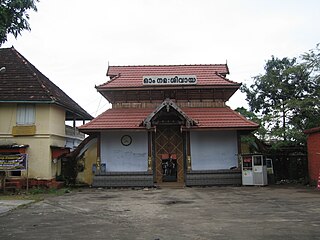
Ernakulam Shiva Temple, also known as Ernakulathappan Temple is one of the major temples of Kerala, located in heart of Ernakulam, Kochi,Kerala, India. The temple, dedicated to Lord Shiva, is considered as the city temple, with the presiding deity as the protector of the city, as per local Hindu faiths and traditions. As per the common practice in Kerala, the deity is reverently called Ernakulathappan, which means Lord of Ernakulam. The temple is located within the Durbar Hall Ground. The temple history itself has deep association with history of the city and was one of the 7 royal temples of Kochi Maharajas. The temple is now under administration of Cochin Devaswam Board. The temple in its current form was built under active patronage of Diwan Sri Edakkunni Sankara Warrier in year 1846 and raised it level of a Royal temple in the Kochi Kingdom. The temple is built on 1-acre (4,000 m2) land. The temple is one of the major Shiva temples in Kerala counted along with the Ettumanoor Mahadevar Temple, Kaduthruthy Mahadeva Temple, Vaikom Temple, Chengannur Mahadeva Temple, Vadakkunathan temple, and Sreekanteswaram Mahadeva Temple, Thiruvananthapuram.

Anikkattilammakshethram is a Hindu Temple situated in Anicadu Village, 3.5 km from Mallappally in Pathanamthitta district in the southern part of Kerala, in the peninsular India.

Nainativu Nagapooshani Amman Temple [Tamil: நயினாதீவு நாகபூசணி அம்மன் கோயில், romanized: Nayiṉātīvu Nākapūcaṇi Am'maṉ Kōyil - Meaning: Nainativu ; Nagapooshani ; Amman (Goddess)] is an ancient and historic Hindu temple located amidst the Palk Strait on the island of Nainativu, Sri Lanka. It is dedicated to Parvati who is known as Nagapooshani or Bhuvaneswari and her consort, Shiva who is named here as Nayinaar. The temple seems to have been mentioned in the Brahmanda Purana. The temple complex houses four gopurams ranging from 20–25 feet in height, to the tallest being the eastern Raja Raja Gopuram soaring at 108 feet high. The temple is a significant symbol for the Tamil people, and has been mentioned since antiquity in Tamil literature, such as Manimekalai and Kundalakesi. The present structure was built during 1720 to 1790 after the ancient structure was destroyed by the Portuguese in 1620. The temple attracts around 1000 visitors a day, and approximately 5000 visitors during festivals. The annual 16-day Mahostavam (Thiruvizha) festival celebrated during the Tamil month of Aani (June/July) - attracts over 100,000 pilgrims. There is an estimated 10,000 sculptures in this newly renovated temple.

The MajorVellayani Devi Temple is a highly revered shrine in Kerala, India, dedicated to goddess Bhadrakali. The shrine is situated in Vellayani 1.5 km west of Vellayani junction, 12 km southeast of Thiruvananthapuram on the eastern bank of Vellayani Lake. The temple is under the management of Travancore Devaswom Board. The temple structure has a bronze roof with traditional art work and carries Dravidian architecture. The temple has eastern and northern towers called Gopurams with statues of different Gods sculptured in them. The Gopurams function as gateways through the walls that surround the temple complex.

The Thirunakkara Mahadevar Temple situated in the heart of Kottayam is one of the 108 revered Shivalayas in central Kerala, India. The temple is about 500 years old and was built by the Raja of Thekkumkur. It also preserves a number of unique sculptures and murals of various Hindu deities. A common belief is that the idol of Shiva here is installed by Parashurama. The Thekkumkur royal family considered the idol as their paradevatha in the form of "Thirunakkara thevar"

Karthyayani Devi Temple, Cherthala is a famous Hindu temple located at Cherthala. Iratti and Thadi are the famous vazhipadu, Cherthala pooram is the second famous pooram in Kerala. Kalabham, in familywise, can be held on there, kalabham is a famous vazhipadu.
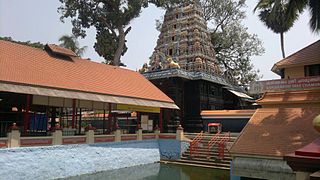
Karikkakom Sree Chamundi Devi Temple or Karikkakom Devi Temple is a temple to three Hindu goddess Chamundi located in Thiruvananthapuram, India at Karikkakom. It is more than 600 years old and enshrines a Panchaloha idol of the goddess Karikkakathamma – an incarnation of Chamundi. Chamundi Devi is worshiped there in three different forms: Maha Chamundi, Raktha Chamundi, and Bala Chamundi.

Evoor Major Srikrishnaswamy temple is a Krishna temple in Evoor near Haripad, in Alappuzha, Kerala. It is said to have originated five millennium ago following Khandava Dahanam. Temple in its current form is built by Moolam Thirunal.

The Arulmigu Balathandayuthapani Temple, also known as the Waterfall Hilltop Temple, is a Hindu temple within George Town in the Malaysian state of Penang. Dedicated to Lord Murugan, the hilltop temple, with its seven-storey 21.6 m-tall gopuram, has been touted as the largest Lord Murugan temple outside India. It is sited comparatively higher above ground than Batu Caves, with devotees having to climb over 500 steps to access the place of worship.
Palkulangara Devi Temple is a Hindu temple in Palkulangara, Thiruvananthapuram, Kerala, India. This place is around 1 km from Pettah junction, 700 m from West Fort junction and 1.5 km from Chakka bypass junction. It is about 1.5 km to the west of Sree Padmanabhaswamy Temple. The temple is under the control of Sree Palkulangara Devi Temple Trust. The temple is an excellent example of Kerala Vasthu Vidya. The abode of Sree Palkulangara Devi is one of the most ancient temples in Kerala. There is also a kavu in the temple.
Sree Dharma Sastha Temple is situated at Thycaud in Thiruvananthapuram City near to Govt. Model School and Govt. Arts College, Kerala, India. This ancient Hindu temple is dedicated to Lord Dharma Sastha. The distance from the temple to Thiruvananthapuram International Airport is 8 km and to the Central Railway Station and Bus Station is 1.5 km. The temple is administered by Nair Service Society.
Andoor Kandan Sree Dharma Sastha Temple is one of the renowned Sastha Temples in south Kerala. It is situated 13 km east of Neyyattinkara i.e. 32 km south-east of Thiruvananthapuram, Kerala. The God Kandan Sree Dharma Sastha is the main deity of this temple. It is considered to be one of the rarest temples in Kerala having the God Sastha facing the west.

Kilimarathukavu Siva Parvathy Temple is a Hindu temple located in Kadakkal, Kollam, Kerala, India. It contains the largest cult image of 'Dharma Sastha', an epithet of Ayyappan.

Avanangattilkalari Sree Vishnumaya Temple is a Hindu temple at Peringottukara, Thrissur District, Kerala state, India. It is dedicated to the god Vishnumaya in Kerala. The god is known also by the names Chathan.














